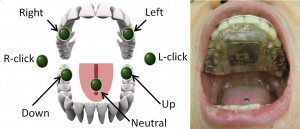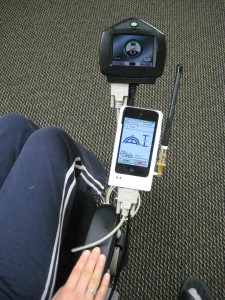The idea of a dental switchboard that was tongue-controlled was first introduced by Alfred Bester in his 1956 award-winning science fiction novel, The Stars My Destination. Now that science fiction has become a reality.

It’s called the Tongue Drive System. Simply by moving their tongues, people with high-level spinal cord injuries can operate a computer or maneuver a standard electrically-powered wheelchair.
Introduced in February of this year at the IEEE International Solid-State Circuits Conference in San Francisco, the newest prototype of the system allows users to wear an inconspicuous dental retainer embedded with sensors to control the system. The sensors track the location of a tiny magnet attached to the user’s tongue. The sensors then wirelessly transmit the signals to an iPod or iPhone, where special software interprets the signals and controls the movements of a cursor on the computer screen or substitutes for the joystick on a powered wheelchair.

In earlier versions of the Tongue Drive System, the tongue magnet sent signals to sensors mounted on a headset worn by the user. “One of the problems we encountered with the earlier headset was that it could shift on a user’s head and the system would need to be recalibrated,” explained Maysam Ghovanloo, an associate professor in the School of Electrical and Computer Engineering at the Georgia Institute of Technology. “Because the dental appliance is worn inside the mouth and molded from dental impressions to fit tightly around an individual’s teeth with clasps, it is protected from these types of disturbances. . . . By moving the sensors inside the mouth, we have created a Tongue Drive System with increased mechanical stability and comfort that is nearly unnoticeable.”
Why the tongue? Actually, there are several reasons why the tongue is particularly well suited for this. Neurologically, the tongue and the mouth are nearly as capable of sophisticated motor control and manipulation tasks as the fingers and hands. The speed and accuracy of the tongue, combined with the fact that it doesn’t easily fatigue, makes it suitable for manipulating assistive devices. Furthermore, the nerve that connects the tongue to the brain usually escapes severe damage in spinal cord injuries and is the last to be affected in most degenerative neuromuscular disorders.
The system can potentially capture a large number of tongue movements, each of which can represent a different user command. The system also provides a framework where a unique set of specific tongue movements could be tailored for each individual, according to the user’s abilities, oral anatomy, personal preferences and/or lifestyle.
The research team has also begun to develop software to connect the Tongue Drive system to a wide variety of readily available communication tools such as text generators, speech synthesizers and readers. In addition, the researchers plan to add control commands, such as switching the system into standby mode to permit the user to eat, sleep or engage in a conversation while extending battery life.
 Computer Technologies Program The Bridge to a Career
Computer Technologies Program The Bridge to a Career